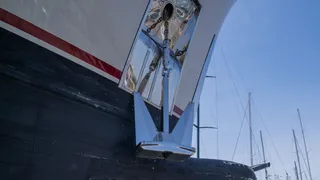For decades, captains have relied on their gut instincts, careful watchkeeping, and GPS alarms when anchoring. Even in today’s tech-rich wheelhouses, the process of setting and monitoring an anchor still purely comes down to judgment.
According to Captain Damien Carr of 23.6-meter Felis, anchoring is still one of the few onboard processes that depends almost entirely on human judgment. “You’re looking at the weather, looking at the chain, and it’s all just sort of a feeling in the moment... It causes a bit of unrest.”
It’s a scenario every captain knows: the guests are swimming, the beach club is open, jet skis are whizzing around and the wind picks up unexpectedly. You scan the surroundings and wonder, "Are we dragging?" This is the moment that AnchorGuardian was designed for — a revolutionary real-time anchor monitoring system.
Developed by Swiss Ocean Tech, AnchorGuardian is the product of over a decade of frustration and innovation. CEO and co-founder Thomas Frizlen, who grew up sailing in Sweden, saw firsthand the stress that came with anchoring, especially in the absence of any hard data. “Whenever you drop anchor, there’s never true peace of mind - you can’t know for certain what’s happening below. Despite how much time we spend at anchor today, we still lack reliable data or hard evidence of what’s really going on underwater.”
AnchorGuardian acts as the eyes and ears of the captain at the seabed, providing critical information in real time about anchor behavior before any problems arise. A battery-powered anchor module is deployed with the anchor and communicates via sonar to a hull-mounted receiver, which is integrated into the yacht’s existing systems through NMEA2000-compatible software.
The data is displayed on a dedicated screen on the bridge or via tablet or mobile, giving captains constant visibility into anchor load and position. During calm conditions, the system can be put into sleep mode to conserve battery and automatically recharges when the anchor is retracted.
AnchorGuardian has even customized components to suit different vessel types. “We have two shipyard clients that produce catamarans, which have longerons between the hulls where the whole anchor arrangement is,” Frizlen explains. “They wanted the AnchorGuardian charging unit to fit into their specific longeron, which has quite a special design, so we adapted it to fit their yachts.”
Carr adds: “They have been great to work with. At one point, it looked like the charging part would disrupt the whole installation, but they went back to the office, redesigned a completely new charging setup and came back on board later to install it. Due to space issues inside the forepeak surrounding the hawse pipe, the engineers designed a system that went inside the hawse pipe. We found that it not only suited the Felis anchor setup but improved the charging efficiency of the module, reducing charging time."
What sets AnchorGuardian apart is its proactive monitoring. Unlike conventional GPS-based drift alarms that monitor the vessel itself, AnchorGuardian monitors the actual anchor, providing early warnings before dragging occurs. Its sensors and proprietary algorithms give captains early insight into what’s really happening below the surface - whether the anchor is sitting at the wrong angle, the load is too high, or there’s not enough chain on the seabed. “It gives you the data to go to the owner and explain why we need to reposition,” Carr says. Instead of reacting in a high-stress moment - calling guests out of the water or powering up the engines abruptly - decisions can be made under calmer circumstances.
While AnchorGuardian is not a substitute for anchor watches, it offers a layer of support, arming crew with objective, real-time data that strengthens professional judgment. “During anchor watches on big boats, you’ll typically have a young deckhand logging the wind speed and direction,” Carr explains. “With AnchorGuardian, they could log things like how much chain they had on the seabed and how much weight was going through the anchor. The captain could use this extra data to say, 'If we end up with less than 20 meters of chain on the seabed, wake me up.' It gives the captain time to act proactively - calmly start the engines, get the crew ready and bring a sense of reassurance to the situation."
In an era of growing environmental regulations, especially around Posidonia seagrass protection in the South of France and the Balearics, the risk of anchor dragging is a legal liability. Dragging into a protected zone could cost thousands in fines, but AnchorGuardian helps reduce that risk by detecting potential anchor movement early and giving crews more time to react.
As more captains experience the benefits of AnchorGuardian, there’s growing consensus that this kind of technology could soon become not just a nice-to-have but a vital tool in a captain’s safety arsenal. For Captain David Badia of 24.6-meter Chévere, the value of AnchorGuardian was clear, given how often his yacht remains at anchor for extended periods: “We have decided to install AnchorGuardian for safety reasons. Our boat spends many days at anchor. An anchorage that we consider safe with no wind can change radically if the weather conditions worsen. Having a device that warns you if the anchoring fails is a major improvement to the safety of the boat.”
Carr adds: “I think a captain will always want AnchorGuardian. Having this extra data doesn’t change your anchoring technique or any of the scenarios, but it does help you build a better picture once you've laid your anchor. I think once more boats have it, it will just become another standard bit of equipment. It’s a really cool piece of technology.”
To find out more about how AnchorGuardian is helping captains sleep easier and keep yachts safer, visit AnchorGuardian’s website.
Sponsored content created for Swiss Ocean Tech

